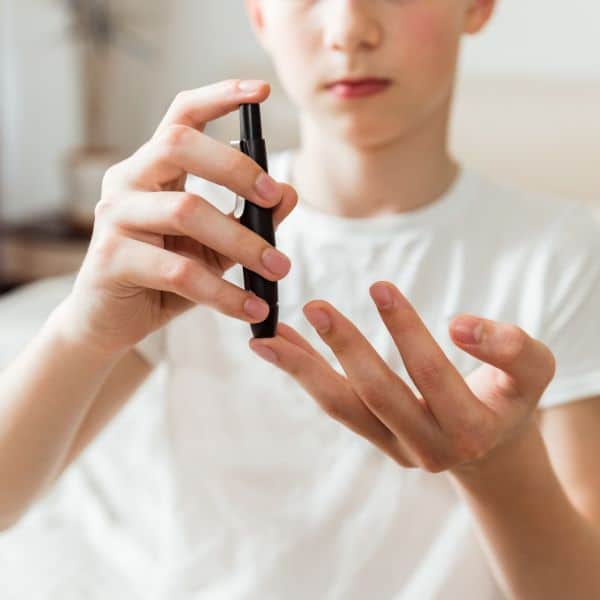What is hyperglycemia?
All you need to know about what happens when you're having a 'hyper' and your blood glucose levels are too high.

If you or someone you love lives with type 1 diabetes (T1D), you’re probably familiar with hyperglycaemia, which is something that happens in your body when your blood glucose levels (BGLs) are too high.
In a person without diabetes, the body naturally produces insulin that acts a bit like a key, allowing the glucose in your blood to enter your cells and be used for energy. But when you have T1D, the body produces very little insulin (or none at all), so this process needs to be managed (for example, by injecting insulin with a syringe or pump).
If you don’t have enough insulin in your body, the sugar essentially stays in your bloodstream, eventually leading to hyperglycaemia. It’s important to be aware of how and why it develops, and how to manage it, too.
(By the way, hyperglycaemia is not to be confused with hypoglycaemia, which happens when your blood glucose levels are too low.)
What causes hyperglycaemia?
There are many reasons your blood glucose levels may be high enough for hyperglycaemia to kick in. These include:
- missing a dose of your medication
- being ill, which can interfere with the way insulin works
- overeating and not exercising enough
- being stressed
- eating more carbs than your body or medication can handle.
Essentially, hyperglycaemia develops when your blood glucose levels reach above 7mmol/l before a meal, and above 8.5mmol/l two hours after a meal.
Signs and symptoms of hyperglycaemia
It’s completely normal for your blood glucose levels to fluctuate throughout the day, and to be slightly over or under your targeted ranges. If you’re still close to your targets, you’re unlikely to experience hyperglycaemia symptoms.
However, if you’re newly diagnosed you may still be learning about managing hyperglycaemia (and hypoglycaemia, too). Here are some common signs and symptoms to be aware of.
Early signs of hyperglycaemia
If your blood glucose levels are just a bit higher than they should be, you might not notice any symptoms at all. But as your BGL starts to rise, symptoms can build slowly over time.
If you suffer these hyperglycaemia symptoms, you need to take immediate action to bring your BGL down:
- feeling very thirsty and peeing more, especially at night
- suddenly losing a lot of weight and not being sure why
- feeling super tired, lacking in energy and generally feeling unwell
- feeling sick and/or having a stomach ache
- suffering frequently from infections like thrush or cystitis
- suffering headaches and/or blurred vision.
Long-term effects of hyperglycaemia
You’ve probably heard from your healthcare team (maybe multiple times) that high blood glucose levels and suffering regular hyperglycaemia symptoms isn’t great for your overall health.
Left unchecked, a high BGL can quickly become dangerous – and long-term complications can be serious, too.
One of the more serious complications is a condition known as diabetic ketoacidosis (DKA). If you don’t have enough insulin to break down the glucose in your system, your body starts burning fat stores for energy instead. As your body burns up fat stores you build up ketones, which can be toxic to the body in large amounts.
The first signs of DKA are feeling thirsty and needing to pee a lot, but if it gets worse it can lead to vomiting, flu-like symptoms, confusion, fruity-smelling breath, rapid breathing, and shortness of breath. It’s really important to seek medical help immediately for DKA.
Other long-term effects of untreated hyperglycaemia can include health issues that affect your sight, kidneys, nerves and heart, so it’s definitely something to get on top of and manage. If hyperglycaemia persists, your doctor may need to modify your medications or the dose you’re taking.
Hyperglycaemia management
It’s the million dollar question: can you completely avoid hyperglycaemia? Short answer: no, not if you’re living with T1D. So many factors can affect your blood glucose levels and hyperglycaemia can’t be avoided completely. But you can do your best to manage it and reduce the risks of it happening.
Here are top tips of how to manage your BGLs on a daily basis.
Try to keep your BGL within your targeted range
Monitor your blood glucose levels regularly throughout the day. Test more often if you’re sick or stressed, as that can cause your BGL to fluctuate.
Exercise regularly
Physical activity helps your body use glucose and makes you more sensitive to insulin. It’s a good idea to talk to an accredited exercise physiologist for a personalised plan.
Monitor your health
Take your medications as prescribed, have a sick day plan to follow, manage stress, and do your best to avoid weight gain. All these things will help prevent hyperglycaemia.
Check your ketones
If you’re feeling unwell or your BGL reads 15mmol/l or higher, you should test your ketones using a special blood ketone monitor.
When to seek help
If your body doesn’t have insulin for around eight hours, things can become dangerous, potentially developing into diabetic ketoacidosis (DKA), as we mentioned above.
If DKA sets in, it can quickly become an emergency situation, leading to coma. For this reason, it’s critical to seek medical help if you start to experience the symptoms above and/or if you’re ill, not eating and drinking as you should or have missed a dose of insulin.
If you’re experiencing hyperglycaemia regularly, it’s also important to keep track of these episodes and chat to your healthcare team, who can work out a plan to help you manage it.
More reading
Want to know more about hyperglycaemia and managing hyperglycaemia symptoms? Check out these great articles:
- Diabetic ketoacidosis
- Your must-have guide to living with type 1 diabetes: Straight to the Point
